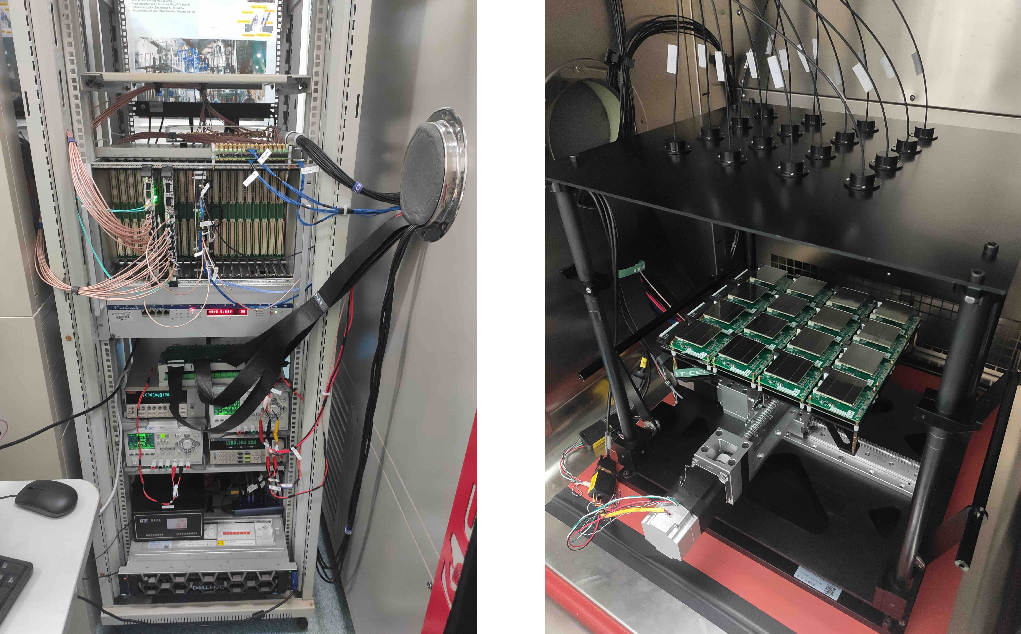Mass testing setup for silicon photomultipliers in TAO Experiment developed
News, 02 September 2024
Employees of the Laboratory of Nuclear Problems at JINR, together with Chinese scientists from Zhengzhou University, the Institute of High Energy Physics of the Chinese Academy of Sciences (CAS), and CAS University developed a unique setup and methods for testing silicon photomultiplier (SiPM) arrays as part of the TAO Experiment.
Modern neutrino physics detectors often employ thousands, and sometimes even hundreds of thousands, of Silicon Photomultipliers (SiPMs). The TAO Experiment is a notable example that utilises a spherical scintillator barrel with a diameter of 1.8 meters, housing approximately 130,000 SiPMs organized into 4,100 tiles. Each tile with size of 5×5 cm2 consists of a 32-SiPM array functioning as a single detector unit. To achieve an unparalleled energy resolution of 2% at 1 MeV within this volume, the SiPMs must possess cutting-edge parameters, including a photon detection efficiency (PDE) exceeding 50%, cross-talk of approximately 10%, and an extremely low dark count rate (DCR) below 50 Hz/mm2. Maintaining the setup at a negative temperature of -50°C is necessary to achieve the desired DCR.
 Facility for mass testing of silicon photomultiplier (SiPM) arrays
Facility for mass testing of silicon photomultiplier (SiPM) arrays
The researchers presented the setup and methods employed to individually characterise the mass of SiPMs across all 4,100 tiles at the specified negative temperature. This unique setup and methodology was developed by the employees of DLNP together with their Chinese colleagues. All design documentation was sent to China for the production of the installation in order to avoid logistical difficulties. This setup enables the simultaneous testing of 16 tiles, measuring the characteristics of each individual photodiode on the array: PDE, cross-talk, noise, single-photovoltaic resolution, gain, dark current, and breakdown voltage to determine the optimal operating point. Measuring the PDE required a stable measured light field, periodically assessed by scanning using calibrated photosensors. One such test cycle takes about three hours, with most of the time spent on cooling and heating the facility in a thermal chamber. Thus, in three months, all 4,100 Hamamatsu photodiode arrays were tested for the JUNO-TAO Experiment.
The article on the development was published in the Journal of Instrumentation in May 2024. Among the authors are researchers from the DLNP Methodical Research Sector Joint Institute Arseny Rybnikov, Nikolai Anfimov, Alexey Chetverikov, Dmitry Fedoseev, Vladimir Kozhukalov, Vladislav Sharov, Sergey Sokolov, and an engineer of the DLNP experimental neutrino physics sector Albert Sotnikov.
The TAO Antineutrino Observatory is part of the JUNO (Jiangmen Underground Neutrino Observatory) International Project, which aims to study the properties of neutrinos and antineutrinos. The specialised cryogenic detector of TAO is designed to work in conjunction with JUNO’s main detector to measure the energy spectrum of antineutrinos from the reactor with record accuracy. The smaller size of the TAO detector is compensated by its improved technical characteristics and optimised design allowing for high measurement accuracy.